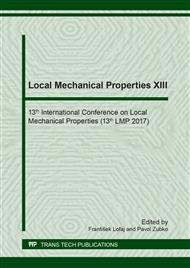[1]
S. Sakka, Handbook of Sol-Gel Science and Technology, Kluwer Academic Publishers, (2004).
Google Scholar
[2]
J. Brus, F. Kolář, V. Machovič, J. Svítilová, Structure of silicon oxycarbide glasses derived from poly (methylsiloxane) and poly [methyl (phenyl) siloxane] precursors, Journal of non-crystalline solids. 289(1) (2001) 62-74.
DOI: 10.1016/s0022-3093(01)00735-9
Google Scholar
[3]
G.M. Renlund, S. Prochazka, R.H. Doremus, Silicon Oxycarbide Glasses .2. Structure and Properties, Journal of Materials Research. 6(12) (1991) 2723-2734.
DOI: 10.1557/jmr.1991.2723
Google Scholar
[4]
P. Greil, Active‐Filler‐Controlled Pyrolysis of Preceramic Polymers, Journal of the American Ceramic Society. 78(4) (1995) 835-848.
DOI: 10.1111/j.1151-2916.1995.tb08404.x
Google Scholar
[5]
A. Strachota, M. Černý, Z. Chlup, M. Šlouf, J. Hromádková, J. Pleštil, H. Šandová, P. Glogar, Z. Sucharda, M. Havelcová, J. Schweigstillová, I. Dlouhý, V. Kozák, Optimization of sol–gel/pyrolysis routes to silicon oxycarbide glasses, Journal of Non-Crystalline Solids. 358(20) (2012).
DOI: 10.1016/j.jnoncrysol.2012.06.027
Google Scholar
[6]
P. Colombo, G. Mera, R. Riedel, G.D. Sorarù, Polymer-Derived Ceramics: 40 Years of Research and Innovation in Advanced Ceramics, Journal of the American Ceramic Society. 93(7) (2010) 1805-1837.
DOI: 10.1111/j.1551-2916.2010.03876.x
Google Scholar
[7]
Y. Hasegawa, M. Iimura, S. Yajima, Synthesis of continuous silicon carbide fibre, Journal of Materials Science. 15(3) (1980) 720-728.
DOI: 10.1007/bf00551739
Google Scholar
[8]
A. Guo, M. Roso, M. Modesti, J. Liu, P. Colombo, Preceramic polymer-derived SiOC fibers by electrospinning, Journal of Applied Polymer Science. 131(3) (2014).
DOI: 10.1002/app.39836
Google Scholar
[9]
M. Černý, A. Strachota, Z. Chlup, Z. Sucharda, M. Žaloudková, P. Glogar, I. Kuběna, Strength, elasticity and failure of composites with pyrolyzed matrices based on polymethylsiloxane resins with optimized ratio of D and T components, Journal of Composite Materials. 47(8) (2012).
DOI: 10.1177/0021998312445591
Google Scholar
[10]
F. Ji, Y.-L. Li, J.-M. Feng, D. Su, Y.-Y. Wen, Y. Feng, F. Hou, Electrochemical performance of graphene nanosheets and ceramic composites as anodes for lithium batteries, Journal of Materials Chemistry. 19(47) (2009) 9063-9067.
DOI: 10.1039/b915838c
Google Scholar
[11]
X. Wang, J. Hu, J. Li, Y. Li, C. Xu, Processing and properties of Cfibre/SiCfillers/SiOC composites using solvent free liquid polysiloxane as matrix source, Advances in Applied Ceramics. 112(8) (2013) 471-477.
DOI: 10.1179/1743676113y.0000000102
Google Scholar
[12]
M. Černý, Z. Sucharda, A. Strachota, Z. Chlup, P. Glogar, Influence of the Organic/Inorganic Pyrolysis Conversion Level on Mechanical Properties of Composites with E-Glass or Basalt Fibre Reinforcement, Ceramics-Silikaty. 54(4) (2010) 345-351.
DOI: 10.1016/j.ceramint.2013.12.102
Google Scholar
[13]
T. Gumula, S. Blazewicz, Thermal conversion of carbon fibres/polysiloxane composites to carbon fibres/ceramic composites, Ceramics International. 39(4) (2013) 3795-3802.
DOI: 10.1016/j.ceramint.2012.10.219
Google Scholar
[14]
G.M. Renlund, S. Prochazka, R.H. Doremus, Silicon Oxycarbide Glasses .1. Preparation and Chemistry, Journal of Materials Research. 6(12) (1991) 2716-2722.
DOI: 10.1557/jmr.1991.2716
Google Scholar
[15]
M. Černý, P. Glogar, Z. Sucharda, Z. Chlup, J. Kotek, Partially pyrolyzed composites with basalt fibres - Mechanical properties at laboratory and elevated temperatures, Composites Part A - Applied Science and Manufacturing. 40(10) (2009).
DOI: 10.1016/j.compositesa.2009.08.002
Google Scholar
[16]
M. Černý, Z. Chlup, A. Strachota, M. Halasová, Š. Rýglová, J. Schweigstillová, J. Svítilová, M. Havelcová, Changes in structure and in mechanical properties during the pyrolysis conversion of crosslinked polymethylsiloxane and polymethylphenylsiloxane resins to silicon oxycarbide glass, Ceramics International. 41(5, Part A) (2015).
DOI: 10.1016/j.ceramint.2015.01.034
Google Scholar
[17]
Z. Chlup, M. Černý, A. Strachota, Z. Sucharda, M. Halasová, I. Dlouhý, Influence of pyrolysis temperature on fracture response in SiOC based composites reinforced by basalt woven fabric, Journal of the European Ceramic Society. 34(14) (2014).
DOI: 10.1016/j.jeurceramsoc.2014.03.003
Google Scholar
[18]
M. Halasova, Z. Chlup, A. Strachota, M. Cerny, I. Dlouhy, Mechanical response of novel SiOC glasses to high temperature exposition, Journal of the European Ceramic Society. 32(16) (2012) 4489-4495.
DOI: 10.1016/j.jeurceramsoc.2012.07.023
Google Scholar
[19]
B.T.-A. Chang, J.C.M. Li, Indentation recovery of amorphous materials, Scripta Metallurgica. 13(1) (1979) 51-54.
DOI: 10.1016/0036-9748(79)90388-0
Google Scholar


